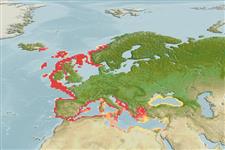Common names from other countries
Classification / Names / Names
俗名 | 同種異名 | Catalog of Fishes (gen., sp.) | ITIS | CoL | WoRMS
Environment: milieu / climate zone / depth range / distribution range
生態學
; 半鹹淡水; 深度上下限 125 - 200 m (Ref. 2754). , preferred 15°C (Ref. 107945)
Northeast Pacific, Northeast Atlantic and Mediterranean Sea: UK, Turkey, Greece; introduced in North America.
Length at first maturity / 大小 / 重量 / 年齡
Maturity: Lm ? range ? - ? cm Max length : 12.0 cm SHH 雄魚/尚未辨別雌雄; (Ref. 88171)
Typically found in rich estuaries and shallow-waters along the tidal zone, attached to stones, compacted mud or silt, muddy sand or gravel substrate, or on bivalve shell fragments. May also be found on wave-exposed areas; and up to depths of 80 m. Prefer salinities between18 to 40; and water temperature of 17°C. Suspension feeders; filters phytoplankton from the ambient waters. Sexual maturity at 3 years. Alternating hermaphrodites; initially producing and releasing sperm as males and then becoming female and producing eggs kept in the mantle cavity where they are fertilized. Highly fecund with 500,000 to more than a million eggs produced by a single individual per year. Incubation in the mantle cavity lasts from 7 to 10 days, followed by a 10 to 30-day planktonic larval veliger stage, until it permanently cements itself with a byssal substance unto the substrate, often in aggregating colonies. Dispersal distances, as influenced by the currents, estimated to be more than 10 km. Life span estimated at 20 to 30 years. A human food source since the Stone Age. German North Sea populations decline began in the late 18th century and attributed to the use of steam ships in oyster fishery; and since the 1950s to 2012, is considered extinct in German waters. Identified hindrance to recolonization include anthropogenic influences such as overfishing and unregulated fishing; presence of invasive species and eutrophication linked to aquaculture; habitat-altering and destructive marine construction activities; poisoning from oil spills and from the liquid biocide, tributyltin hydride, in anti-fouling marine paint used in commercial shipping; as well as temperature and osmotic stress due to climate change (Ref. 88171).
Life cycle and mating behavior
成熟度 | 繁殖 | 產卵場 | 卵 | 孕卵數 | 仔魚
Members of the class Bivalvia are mostly gonochoric, some are protandric hermaphrodites. Life cycle: Embryos develop into free-swimming trocophore larvae, succeeded by the bivalve veliger, resembling a miniature clam.
主要參考資料
參考文獻 | 合作者 | 合作者
Demir, M. 2003. (Ref. 2754)
IUCN 瀕危狀態 (Ref. 130435)
CITES狀態 (Ref. 108899)
Not Evaluated
Not Evaluated
人類使用
漁業: 商業性
FAO - 養殖: 產生, 魚種描繪; 漁業: landings | FishSource | 周邊海洋
工具
更多資訊
年龄/大小
成長
長度-重量
長度-長度
型態特徵
仔魚
豐度
網路資源
Estimates based on models
Preferred temperature
(Ref.
115969): 7.1 - 11.9, mean 9.7 (based on 65 cells).
